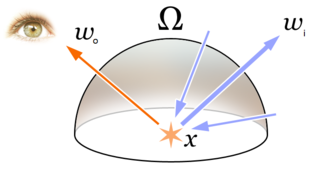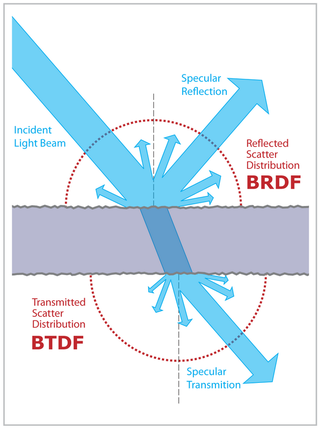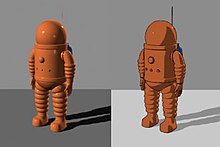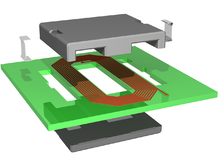
Rendering or image synthesis is the process of generating a photorealistic or non-photorealistic image from a 2D or 3D model by means of a computer program. The resulting image is referred to as the render. Multiple models can be defined in a scene file containing objects in a strictly defined language or data structure. The scene file contains geometry, viewpoint, texture, lighting, and shading information describing the virtual scene. The data contained in the scene file is then passed to a rendering program to be processed and output to a digital image or raster graphics image file. The term "rendering" is analogous to the concept of an artist's impression of a scene. The term "rendering" is also used to describe the process of calculating effects in a video editing program to produce the final video output.
Metropolis light transport (MLT) is a global illumination application of a variant of the Monte Carlo method called the Metropolis–Hastings algorithm to the rendering equation for generating images from detailed physical descriptions of three-dimensional scenes.

A particle system is a technique in game physics, motion graphics, and computer graphics that uses many minute sprites, 3D models, or other graphic objects to simulate certain kinds of "fuzzy" phenomena, which are otherwise very hard to reproduce with conventional rendering techniques – usually highly chaotic systems, natural phenomena, or processes caused by chemical reactions.

Boids is an artificial life program, developed by Craig Reynolds in 1986, which simulates the flocking behaviour of birds. His paper on this topic was published in 1987 in the proceedings of the ACM SIGGRAPH conference. The name "boid" corresponds to a shortened version of "bird-oid object", which refers to a bird-like object.

In scientific visualization and computer graphics, volume rendering is a set of techniques used to display a 2D projection of a 3D discretely sampled data set, typically a 3D scalar field.

The Catmull–Clark algorithm is a technique used in 3D computer graphics to create curved surfaces by using subdivision surface modeling. It was devised by Edwin Catmull and Jim Clark in 1978 as a generalization of bi-cubic uniform B-spline surfaces to arbitrary topology.

In computer graphics, the rendering equation is an integral equation in which the equilibrium radiance leaving a point is given as the sum of emitted plus reflected radiance under a geometric optics approximation. It was simultaneously introduced into computer graphics by David Immel et al. and James Kajiya in 1986. The various realistic rendering techniques in computer graphics attempt to solve this equation.

3D rendering is the 3D computer graphics process of converting 3D models into 2D images on a computer. 3D renders may include photorealistic effects or non-photorealistic styles.

The definition of the BSDF is not well standardized. The term was probably introduced in 1980 by Bartell, Dereniak, and Wolfe. Most often it is used to name the general mathematical function which describes the way in which the light is scattered by a surface. However, in practice, this phenomenon is usually split into the reflected and transmitted components, which are then treated separately as BRDF and BTDF.

Patrick M. Hanrahan is an American computer graphics researcher, the Canon USA Professor of Computer Science and Electrical Engineering in the Computer Graphics Laboratory at Stanford University. His research focuses on rendering algorithms, graphics processing units, as well as scientific illustration and visualization. He has received numerous awards, including the 2019 Turing Award.

Fluid animation refers to computer graphics techniques for generating realistic animations of fluids such as water and smoke. Fluid animations are typically focused on emulating the qualitative visual behavior of a fluid, with less emphasis placed on rigorously correct physical results, although they often still rely on approximate solutions to the Euler equations or Navier–Stokes equations that govern real fluid physics. Fluid animation can be performed with different levels of complexity, ranging from time-consuming, high-quality animations for films, or visual effects, to simple and fast animations for real-time animations like computer games.

Computer graphics is a sub-field of computer science which studies methods for digitally synthesizing and manipulating visual content. Although the term often refers to the study of three-dimensional computer graphics, it also encompasses two-dimensional graphics and image processing.

Andrew Paul Witkin was an American computer scientist who made major contributions in computer vision and computer graphics.

In scientific visualization, line integral convolution (LIC) is a method to visualize a vector field, such as fluid motion.
In computer graphics, free-form deformation (FFD) is a geometric technique used to model simple deformations of rigid objects. It is based on the idea of enclosing an object within a cube or another hull object, and transforming the object within the hull as the hull is deformed. Deformation of the hull is based on the concept of so-called hyper-patches, which are three-dimensional analogs of parametric curves such as Bézier curves, B-splines, or NURBs. The technique was first described by Thomas W. Sederberg and Scott R. Parry in 1986, and is based on an earlier technique by Alan Barr. It was extended by Coquillart to a technique described as extended free-form deformation, which refines the hull object by introducing additional geometry or by using different hull objects such as cylinders and prisms.
Maureen C. Stone is an American computer scientist, specializing in color modeling.

Nadia Magnenat Thalmann is a computer graphics scientist and robotician and is the founder and head of MIRALab at the University of Geneva. She has chaired the Institute for Media Innovation at Nanyang Technological University (NTU), Singapore from 2009 to 2021.
Gradient domain image processing, also called Poisson image editing, is a type of digital image processing that operates on the differences between neighboring pixels, rather than on the pixel values directly. Mathematically, an image gradient represents the derivative of an image, so the goal of gradient domain processing is to construct a new image by integrating the gradient, which requires solving Poisson's equation.

Gooch shading is a non-photorealistic rendering technique for shading objects. It is also known as "cool to warm" shading, and is widely used in technical illustration.
Michael F. Cohen is an American computer scientist and researcher in computer graphics. He was a senior research scientist at Microsoft Research for 21 years until he joined Facebook Research in 2015. In 1998, he received the ACM SIGGRAPH CG Achievement Award for his work in developing radiosity methods for realistic image synthesis. He was elected a Fellow of the Association for Computing Machinery in 2007 for his "contributions to computer graphics and computer vision." In 2019, he received the ACM SIGGRAPH Steven A. Coons Award for Outstanding Creative Contributions to Computer Graphics for “his groundbreaking work in numerous areas of research—radiosity, motion simulation & editing, light field rendering, matting & compositing, and computational photography”.

















